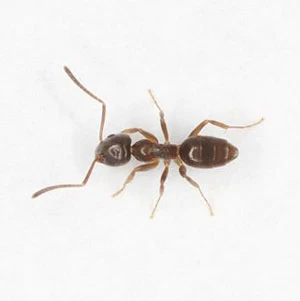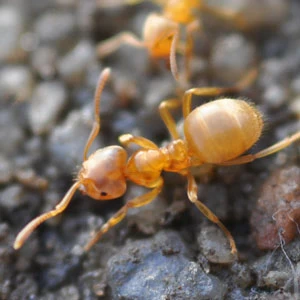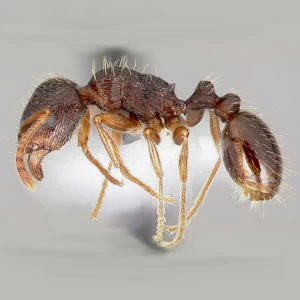


Bugging
You?
Ants
Apex offers various pest control services for different types of ants to ensure your location is ant free! Several Ant Pest Control species can invade your living space. Some are just foraging for food and water, while others are looking to establish a satellite colony in the timbers of your home, causing costly property damage. If suitable conditions are found, a pheromone trail is left behind for other ants to follow. Hence, hiring an ant exterminator to tackle the problem as soon as you start seeing them is essential.
Inside your home, it is essential to inspect baseboard cracks, carpet edges, window and door frames, water sources, areas where plumbing leaks have occurred, and all areas of the kitchen. Outside your home, it is essential to inspect the perimeter landscaping, trees, tree stumps, rotten wood, mulch areas, and woodpiles, to name a few. Depending on the species, the homeowner mustn’t try to tackle the problem with over-the-counter products.
In most instances, using the wrong product will worsen the problem (a process called budding where the colony separates and multiple colonies are formed). When it comes to wood-infesting ants like carpenter ants, spraying or baiting alone will not do it. You need to locate where they are nesting in the home and treat it directly to eliminate the threat. Ant Pest Control can be very tricky. Call our ant exterminators at Apex today for a customized natural ant treatment plan.
Ants Identification
Identifying the pest is the first step of eradication. The carpenter ant, odorous house ant, pavement ant, pharaoh ant, giant yellow ant, and thief ant are common ant species that may be plaguing your property.

Carpenter Ant
Identification Tips:
- Color: Usually black, red, brown, or a combination of red and black
- Legs: 6
- Size: Workers range from 1/8 to 1/2 inches long
- Identifying Characteristics: 3-segmented body; one node; elbowed antennae; constricted waist; reproductives have forewings larger than hind wings.
Characteristics of this insect:
- The main colony may be located outside the structure, with several satellite colonies situated in the structure
- Nests are usually established in soft, moist (not too wet), decayed wood or in an existing wall void that may be completely dry
- Does not consume wood. Workers excavate irregular, smooth, and clean galleries, usually along the grain of the wood but sometimes across the grain in softer portions of wood. Homeowners may see piles of sawdust and fragments of insects expelled from galleries.
- Diet consists of both plant and animal origin, such as plant juices, fresh fruits, insects, meats, syrup, honey, jelly, sugar, grease, fat, and honeydew (aphid excrement)

Odorous House Ant
Identification Tips:
- Color: Dark brown to black
- Legs: 6
- Size: Small workers ranging from 1/16 to 1/8 inches long
- Identifying Characteristics: 3-segmented body; one node; 12 segmented antennae not terminated with a club; bitter odor when crushed, which is similar to the pungent smell of decaying coconut husk
Characteristics of this insect:
- Considered a scavenger that will eat most household foods but prefers those that contain sugar
- Outside they construct shallow nests in the soil underneath objects such as stones, patio blocks, and debris. Inside, they prefer areas with moisture, such as around hot water pipes, heaters, or insulation, to name a few.
- Colonies range in size from 100 – 100,000, with multiple queens
- Workers actively forage along trails when temperatures are cool, even down to 50 degrees Fahrenheit
Pavement Ant
Identification Tips:
- Color: Light to dark brown to blackish
- Legs: 6
- Size: Workers range from 1/12 to 1/4 inches long
- Identifying Characteristics: 3-segmented body; two nodes; 12-segment antennae (ends in a 3-segmented club): head and thorax furrowed with deep grooves; piles of dirt/concrete indicative of this ant
Characteristics of this insect:
- Individual colonies may contain thousands of workers and multiple queens and are usually located at one particular site
- As the name implies, this ant earns its name by building nests beneath and along the sides of pavement: patios, driveways, sidewalks, and foundations of homes. It may be found in kitchens, bathrooms, basements, baseboards, and wall voids, to name a few.
- Swarming of reproductives (which look nothing like the picture above) can occur any time of the year but usually in the Spring (based on mild heat, humidity, etc.)
- Diet consists of various foods, including grease, sweets, seeds, honeydew produced by aphids, and dead insects. Pet foods or any food dropped on the floor will be quickly engulfed with this ant.
Pharaoh Ant
Identification Tips:
- Color: Yellowish to orange/reddish, with a shiny dark abdomen
- Legs: 6
- Size: Workers are about 1/16 inch long
- Identifying Characteristics: 3-segmented body; two nodes; 12 segmented antennae with the 3-segmented club; males 1/16 inch long, black in appearance, possess wings, and have a stinger (although seldom used)
Characteristics of this insect:
- Form trails and are attracted to grease, meats, insects, and sweets. Prefer warm areas (80 to 85 degrees Fahrenheit)
- Active year-round in houses and portions of more significant buildings such as hospitals, food handling establishments, office buildings, and apartments, to name a few. They can be found in wall voids, behind baseboards, stacks of papers, bed linens, and bandage packs.
- Colonies are large, have multiple queens, and increase by “budding” – one portion of the territory goes with each queen.
- Believe it or not, these ants have turned up in IV tubes, medicine droppers, and bandage stacks.

Large Yellow Ant (Citronella Ant)
Identification Tips:
- Color: Yellowish to orange
- Legs: 6
- Size: 1/8-3/16 inches
- Identifying Characteristics: Antennae 12-segmented with segments gradually enlarging towards the tip; compound eyes small about the head; one-node
Characteristics of this insect:
- The giant yellow smells of lemon when crushed and also goes by the name: Citronella.
- The species burrows beneath the ground to build their colony. A large amount of soil is excavated as the species dig holes to form their tunnels in the territory. The settlement is usually found underneath decks, logs, rocks, and outdoor patios.
- The ants swarm any time of year, indoors or outdoors. The ants will not reproduce once inside or attack stored goods or structures.
- Often forming colonies in wood previously damaged by termites may signify moisture issues or termite damage.
Thief Ant
Identification Tips:
- Color: Yellow to orange-red in color with a dark abdomen
- Legs: 6
- Size: 1/16 inch long
- Identifying Characteristics: Antennae has ten segments and ends in a two-segmented club; the stinger at the tip of the abdomen is so tiny that it is rarely used effectively, most often confused with the Pharaoh ant.
Characteristics of this insect:
- Inside, these Ant Pest Control nest in small crevices and masonry and move between rooms via wires and conduit. Outside, they nest in exposed soil or underneath objects, in the trash, rotten wood, and cavities in trees.
- Colonies are composed of a few hundred to several thousand workers with many queens.
- Thief ants will feed on insects Ant Pest Control and dead rodents. Pathogens from this matter can be transmitted to humans if the insect comes into contact with food products. The insect also enjoys feeding on protein, sweets, and other greasy foods like peanut butter.
- The ant’s namesake originates from its habit of stealing food and larvae from neighboring colonies.
*Image courtesy of The photographer and www.antweb.org. Licensed under Creative CommonsAttribution-Share Alike 3.0 Unported.



